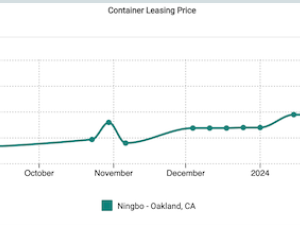In the case of rolling stock, Wallenius Wilhelmsen Logistics (WWL) has a simple approach to a complex transportation problem. Call it alpha-to-omega, soup-to-nuts or factory-to-dealer, the bottom line is WWL provides service from the beginning to the end of the supply chain.
By George Lauriat, Editor-in-Chief, AJOT
Wallenius Wilhelmsen Logistics (WWL) is in the business of moving rolling stock around the world, principally inside its massive roll-on roll-off (ro-ro) vessels. And while it's hard to ignore a ro-ro ship pulling into port with its flat fortress-like sides of the hull, bridge-work perched like a castle's keep and massive doors designed to disgorge vehicles into terminal lots, this belies the complex business behind the scenes.
Chris Connor, WWL's Deputy CEO and President of the Americas, is a veteran of the ro-ro segment of the ship business and is quick to point out 'our scope of interest is factory-to-dealer.' In many cases, that means from the OEM's (Original Equipment Manufacturer) factory right to the dealer's lot. From the WWL perspective they link this supply chain together by providing 'terminal services, supply chain management, ocean transportation, inland distribution and technical services.'
WWL has eleven marine terminals in various locations around the world that it typically leases (usually from a Port Authority) and manages primarily for its own operations. For example, in December 2001, WWL opened a 50-acre marine terminal (now at 59 acres) at the Port of Baltimore for its vessel and terminal processing operations. In 2007, the operation expanded to a full-service factory-to-dealer facility that included a new 72-acre vehicle processing center (VPC) and 19 acre heavy equipment processing center (EPC). The annual volume of vehicles passing through the centre is approximately 124,000 units.
In addition, WWL has another fifty auto and heavy equipment technical service sites located around the world that as Connor explains, 'act as an extension of the OEM's own factory.' While ocean transportation on ro-ro vessels is the framework, WWL complements its product offering to clients via its marine terminals, technical service sites, inland distribution management and supply chain visibility tools.
'Our [WWL] core investment is with our ships and terminals, but our business model extends our services throughout the supply chain to support our customers.'
Connor explained that some customers utilize complete 'supply chain management' that enables the OEM to have visibility from the factory to dealership.
Other clients prefer a more chain link-by-chain link approach. 'On the inland side, we might manage the distribution of vehicles from our processing hub to dealers or conversely from the manufacturer to the processing center, or the entire transportation [process],' Connor said. For inland distribution, manufacturers pay a straight fee to WWL for managing this part of the chain. WWL negotiates (sometimes both the manufacturer and WWL negotiate with the transportation providers) the actual transportation of the vehicles to the final destination. In the case of technical services, WWL provides technical services to accessorize or 'finish' the vehicle. 'Our [WWL] technical services are like an extension of the OEM's factory. Often the technicians are trained by the OEM,' Connor added. 'The technical services allow a manufacturer to customize its product at the last minute to meet the demand of its customers.' 'Furthermore, the manufacturer can also store vehicles and have them released to meet demand as needed, helping smooth out production and delivery schedules.'
Connor noted that OEMs like to keep their production as basic as possible to increase efficiency and velocity. By leaving the 'customization' to the 'technical services' operation at WWL's processing or distribution center, the OEM is able to remain product flexible without incurring extra cost or great changes to the factory assembly line.
CAT
Although their m





